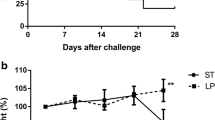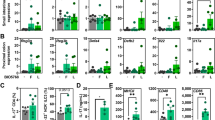Abstract
Purpose
The aim of this study was to better characterise the biological effects of Lactobacillus salivarius ssp. salivarius CECT5713, a probiotic with immunomodulatory properties.
Methods
Live or dead probiotic was assayed in the TNBS model of rat colitis to determine whether viability was a requisite to exert the beneficial effects. In vitro studies were also performed in Caco-2 cells to evaluate its effects on epithelial cell recovery and IL-8 production. Finally, the probiotic was assayed in the LPS model of septic shock in mice to establish its effects when there is an altered systemic immune response.
Results
The viability of the probiotic was required for its anti-inflammatory activity. The probiotic inhibited IL-8 production in stimulated Caco-2 cells and facilitated the recovery of damaged intestinal epithelium. In LPS-treated mice, the probiotic inhibited the production of TNFα in plasma and lungs and increased the hepatic glutathione content. These effects were associated with an improvement in the altered production of the T-cell cytokines in splenocytes, by reducing IL-2 and IL-5 and by increasing IL-10. Finally, it reduced the increased plasma IgG production in LPS-treated mice.
Conclusion
The anti-inflammatory effects of viable L. salivarius ssp. salivarius CECT5713 are not restricted to the gastrointestinal tract.




Similar content being viewed by others
References
Boirivant M, Strober W (2007) The mechanism of action of probiotics. Curr Opin Gastroenterol 23:679–692
Collado MC, Isolauri E, Salminen S, Sanz Y (2009) The impact of probiotic on gut health. Curr Drug Metab 10:68–78
Damaskos D, Kolios G (2008) Probiotics and prebiotics in inflammatory bowel disease: microflora ‘on the scope’. Br J Clin Pharmacol 65:453–467
Bernstein CN, Blanchard JF, Rawsthorne P, Yu N (2001) The prevalence of extraintestinal diseases in inflammatory bowel disease: a population-based study. Am J Gastroenterol 96:1116–1122
McCarthy J, O’Mahony L, O’Callaghan L et al (2003) Double blind, placebo controlled trial of two probiotic strains in interleukin 10 knockout mice and mechanistic link with cytokine balance. Gut 52:975–980
Peran L, Camuesco D, Comalada M et al (2005) Preventative effects of a probiotic, Lactobacillus salivarius ssp. salivarius, in the TNBS model of rat colitis. World J Gastroenterol 11:5185–5192
Flynn S, van Sinderen D, Thornton GM, Holo H, Nes IF, Collins JK (2002) Characterization of the genetic locus responsible for the production of ABP-118, a novel bacteriocin produced by the probiotic bacterium Lactobacillus salivarius subsp. salivarius UCC118. Microbiology 148:973–984
Olivares M, Díaz-Ropero MP, Martín R, Rodríguez JM, Xaus J (2006) Antimicrobial potential of four Lactobacillus strains isolated from breast milk. J Appl Microbiol 101:72–79
Rachmilewitz D, Katakura K, Karmeli F et al (2004) Toll-like receptor 9 signaling mediates the anti-inflammatory effects of probiotics in murine experimental colitis. Gastroenterology 126:520–528
Strober W, Fuss IJ, Blumberg RS (2002) The immunology of mucosal models of inflammation. Annu Rev Immunol 20:495–549
Dotan I, Allez M, Nakazawa A, Brimnes J, Schulder-Katz M, Mayer L (2007) Intestinal epithelial cells from inflammatory bowel disease patients preferentially stimulate CD4+ T cells to proliferate and secrete interferon-gamma. Am J Physiol Gastrointest Liver Physiol 292:G1630–G1640
Camuesco D, Peran L, Comalada M et al (2005) Preventative effects of lactulose in the trinitrobenzenesulphonic acid model of rat colitis. Inflamm Bowel Dis 11:265–271
Krawisz JE, Sharon P, Stenson WF (1984) Quantitative assay for acute intestinal inflammation based on myeloperoxidase activity. Assessment of inflammation in rat and hamster models. Gastroenterology 87:1344–1350
Anderson ME (1985) Determination of glutathione and glutathione disulfide in biological samples. Meth Enzymol 113:548–555
Comalada M, Camuesco D, Sierra S, Ballester I, Xaus J, Gálvez J, Zarzuelo A (2005) In vivo quercitrin anti-inflammatory effect involves release of quercetin, which inhibits inflammation through down-regulation of the NF-kappaB pathway. Eur J Immunol 35:584–592
Bailón E, Camuesco D, Nieto A et al (2007) The intestinal anti-inflammatory effects of the novel agent UR-1505 in the TNBS model of rat colitis are mediated by T-lymphocyte inhibition. Biochem Pharmacol 74:1496–1506
Shibolet O, Karmeli F, Eliakim R et al (2002) Variable response to probiotics in two models of experimental colitis in rats. Inflamm Bowel Dis 8:399–406
Ma D, Forsythe P, Bienenstock J (2004) Live Lactobacillus reuteri is essential for the inhibitory effect on tumor necrosis factor alpha-induced interleukin-8 expression. Infect Immun 72:5308–5314
Llopis M, Antolin M, Carol M et al (2009) Lactobacillus casei downregulates commensals’ inflammatory signals in Crohn’s disease mucosa. Inflamm Bowel Dis 15:275–283
Hisamatsu T, Ogata H, Hibi T (2008) Innate immunity in inflammatory bowel disease: state of the art. Curr Opin Gastroenterol 24:448–454
Lewis K, Caldwell J, Phan V et al (2008) Decreased epithelial barrier function evoked by exposure to metabolic stress and nonpathogenic E. coli is enhanced by TNF-alpha. Am J Physiol Gastrointest Liver Physiol 294:G669–G678
Díaz-Ropero MP, Martín R, Sierra S et al (2007) Two Lactobacillus strains, isolated from breast milk, differently modulate the immune response. J Appl Microbiol 102:337–343
O’Hara AM, O’Regan P, Fanning A et al (2006) Functional modulation of human intestinal epithelial cell responses by Bifidobacterium infantis and Lactobacillus salivarius. Immunology 118:202–215
Baharav E, Mor F, Halpern M, Weinberger A (2004) Lactobacillus GG bacteria ameliorate arthritis in Lewis rats. J Nutr 134:1964–1969
So JS, Kwon HK, Lee CG et al (2008) Lactobacillus casei suppresses experimental arthritis by down-regulating T helper 1 effector functions. Mol Immunol 45:2690–2699
Isolauri E, Arvola T, Sütas Y, Moilanen E, Salminen S (2000) Probiotics in the management of atopic eczema. Clin Exp Allergy 30:1604–1610
Rosenfeldt V, Benfeldt E, Nielsen SD, Michaelsen KF, Jeppesen DL, Valerius NH, Paerregaard A (2003) Effect of probiotic Lactobacillus strains in children with atopic dermatitis. J Allergy Clin Immunol 111:389–395
Arribas B, Rodríguez-Cabezas ME, Comalada M et al (2009) Evaluation of the preventative effects exerted by Lactobacillus fermentum in an experimental model of septic shock induced in mice. Br J Nutr 101:51–58
Arribas B, Rodríguez-Cabezas ME, Camuesco D et al (2009) A probiotic strain of Escherichia coli, Nissle 1917, given orally exerts local and systemic anti-inflammatory effects in lipopolysaccharide-induced sepsis in mice. Br J Pharmacol 157:1024–1033
Sheil B, McCarthy J, O’Mahony L et al (2004) Is the mucosal route of administration essential for probiotic function? Subcutaneous administration is associated with attenuation of murine colitis and arthritis. Gut 53:694–700
Annane D, Bellissant E, Cavaillon JM (2005) Septic shock. Lancet 365:63–78
Kim GY, Roh SI, Park SK, Ahn SC, Oh YH, Lee JD, Park YM (2003) Alleviation of experimental septic shock in mice by acidic polysaccharide isolated from the medicinal mushroom Phellinus linteus. Biol Pharm Bull 26:1418–1423
Damaskos D, Kolios G (2008) Probiotics and prebiotics in inflammatory bowel disease: microflora ‘on the scope’. Br J Clin Pharmacol 65:453–467
Arad G, Hillman D, Levy R, Kaempfer R (2004) Broad-spectrum immunity against superantigens is elicited in mice protected from lethal shock by a superantigen antagonist peptide. Immunol Lett 91:141–145
Acknowledgments
This study was supported by the Spanish Ministry of Science and Innovation (SAF2008-02616) with funds from the European Union and by Junta de Andalucia (CTS 164). Mònica Comalada is a recipient of Ramon y Cajal Programme from Spanish Ministry of Science and Technology. Desirèe Camuesco is a postdoctoral fellow of the Spanish Ministry of Science and Innovation; Maria Elena Rodríguez-Cabezas is a postdoctoral fellow of CIBER-EHD. The CIBER-EHD is funded by the Instituto de Salud Carlos III.
Author information
Authors and Affiliations
Corresponding author
Additional information
E. Rodríguez-Cabezas and J. Gálvez contributed equally to the supervision of the study.
Rights and permissions
About this article
Cite this article
Arribas, B., Garrido-Mesa, N., Perán, L. et al. The immunomodulatory properties of viable Lactobacillus salivarius ssp. salivarius CECT5713 are not restricted to the large intestine. Eur J Nutr 51, 365–374 (2012). https://doi.org/10.1007/s00394-011-0221-4
Received:
Accepted:
Published:
Issue Date:
DOI: https://doi.org/10.1007/s00394-011-0221-4




